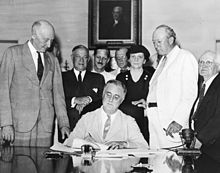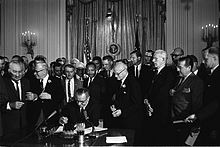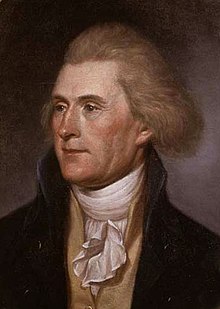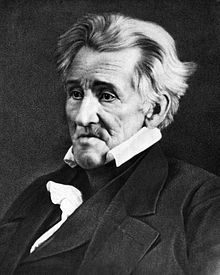Democratic Party (United States)
The Democratic Party (also referred to as Democrats or Dems for short) is the larger of the two major parties in the USA, with around 45.7 million registered supporters alongside the Republican Party. Originally a party that advocated racial segregation, the Democrats are now considered more (left)liberal, less conservative, and more oriented toward political progressivism compared to the Republicans. Their unofficial heraldic animal is the donkey, although unlike the Republican elephant, it has never been officially adopted as such. Its origin, like the Republican elephant, can be traced to cartoonist Thomas Nast. The Democrats' equally unofficial party color is blue. In TV shows or media reports, Democratic Party senators and party members are usually depicted with a "(D)" after their name. The Democrats are the oldest political party in the world still in existence.
The founding of the party dates back to Thomas Jefferson and the year 1792. In 1828, Andrew Jackson and others built a mass party. While the Democrats were initially the more conservative of the two parties, by the early 20th century it had evolved into an ideologically less coherent alliance of progressive politicians in the large cities of the North, who appealed primarily to workers and immigrants, and conservative Southerners who defended the existing order. During Woodrow Wilson's presidency (1913-1921), and especially through the reforms of the New Deal (1933-1938), the Democrats became more and more identified with progressive social policies in contrast to the economic liberalism of the Republicans. After the party convention of 1948, when many mostly Southern segregationist advocates left the party in disagreement, the Democrats had been leaders since the 1960s in realizing the demands of the civil rights movement, desegregation, and equality for minorities: The party increasingly turned to socially liberal ideas. Since the originally progressive Republicans moved to the right for their part at the latest from 1964 onwards, the two parties now clearly represent the two poles in a right-left spectrum.
Like parties in the US in general, the Democrats are organized much differently than European parties. For example, depending on the state, district caucuses are partly elected by the general electorate in primary elections, rather than by party members alone. The most important body for the party as a whole is the Democratic National Committee (DNC), which also organises the Democratic National Convention (the party convention held every four years to select the respective presidential candidate); the current chairman of the DNC is Jaime Harrison.
In seven of the last eight presidential elections, the Democratic candidates won the majority of the votes cast (popular vote); only 2004 was an exception. With Joe Biden, the party has provided the 46th US president since 2021. In the congressional elections in November 2020, the Democrats were able to defend their majority in the House of Representatives, which they lost in 2010 and regained in 2018. In the Senate, too, the Democratic faction has had a majority again since the beginning of 2021, after losing it in 2015.
History
Development phase
The forerunners of the Democratic Party were the Anti-Administration Party and the coalition around Thomas Jefferson in Congress in 1792, which was intended to undermine the policies of the then US Secretary of the Treasury Alexander Hamilton. From the first quarter of the 19th century, the former main opponents of Jefferson's party, which was then still known as the Republicans (later Democratic Republicans), the Federalists around Alexander Hamilton and John Adams, were no longer politically active. Therefore, Jefferson's party was the only one to dominate the so-called Era of Good Feelings (ca. 1814-1830).
In the late 1820s and the 1830s, almost all the states of the USA abolished the voting restrictions that had hitherto existed on the basis of wealth and taxation, so that almost all white men became eligible to vote and the first democracy in the modern sense came into being; in addition, the population of the USA rose sharply as a result of immigration. Overall, therefore, the number of voters increased massively. The parties that had existed in the US up to that point (including Jefferson's party) were essentially small, informal voting clubs that were no match for the mass democracy that was now emerging. Not only Thomas Jefferson, but Andrew Jackson, who was the seventh president of the United States from 1829 to 1837, is honored as the founding father of the party. He ran in the 1824 presidential election, as did as many as three other candidates from the Democratic Republicans of the time, leading to a split in the only nationwide party. Jackson lost the election very narrowly to John Quincy Adams, whereupon Adams supporters from the party became the National Republicans, while the Jeffersonian Democrats formed into the new Democratic Party, which saw itself in the tradition of Jefferson. From 1828 to 1830, Andrew Jackson and Martin Van Buren, the senator from New York, formed the Democratic Party, the first tightly organized popular party in the world. The year 1828 is therefore considered the founding year of the Democrats. Their opponents from the short-lived National Republican Party organized themselves as Whigs after Jackson's ouster of Adams in 1828 and Henry Clay's defeat in 1832, and from 1854 increasingly with the newly formed Republican Party.
In a line of tradition with Thomas Jefferson, Jackson represented the interests of ordinary people (especially from rural areas and the poorer part of the population, increasingly also immigrants and Catholics). He opposed a national bank of the United States, fought protectionism, and supported slavery. Distrusting the growth of large cities, he favored a more even distribution of population. Therefore, both he and his successors massively supported the fight against the Indians, who still owned large areas of rural land at the time. Jackson is considered an early exponent of populism as well as the first American politician to build a party machine in the modern sense of the word.
Second half of the 19th century
In the years before 1860, because of the divisiveness of their opponents and by consistently exploiting certain features of the Constitution, the Democrats managed to control the U.S. government even though only a minority of the electorate backed them. Before the Civil War, however, the party faced a test of strength because of the slavery issue. On the occasion of the presidential election of 1860, it split and sent different candidates into the race for the presidency in the North and the South. When, as a result of this disunity, the Republican Abraham Lincoln was elected, this triggered the War of Secession. After the Civil War ended in 1865, Republicans dominated the South and initially parts of the North because many who had cooperated with the Confederacy were disfranchised during the military occupation of the Southern states called "Reconstruction." It was not until the end of "Reconstruction" that the Democrats again played a significant role at the national level. Their bastion of power was mainly in the South (Solid South), but also in the large cities of the North, where they found support among workers, immigrants and Catholics.
From the Populist movement at the end of the century, the party adopted new ideas and increasingly fought industrial cartels and "railroad barons." With the candidacy of William Jennings Bryan in 1896, the Democrats' "left-wing profile" strengthened. During this period, it streamlined its party organization and the party's internal "bosses principle." However, accusations of corruption were also increasingly raised against the party. At the same time, the party adhered to the principle of racial segregation and consistently exploited the freedom of action regained after the end of Reconstruction to curtail the rights of blacks in the southern states (Jim Crow laws).
Since the 20th century
It was not until the early 20th century that progressivist-oriented reformers began to gain influence in the party. The Democratic Party increasingly advocated social reforms in the form of enlightened social liberalism, such as a general income tax, direct election of the Senate, alcohol prohibition, and women's suffrage. Democratic President Woodrow Wilson attempted to establish the League of Nations, the forerunner of the UN. The League of Nations was formed, but the U.S., of all nations, did not join because this plan failed to find a majority in the increasingly isolationist Congress.
A high point of these reforms, which many even consider the pinnacle of an American, non-Marxist version of social democracy, was the New Deal under President Franklin D. Roosevelt in response to the Great Depression of the 1930s. Roosevelt in response to the Great Depression of the 1930s. Among other things, lawmakers under Roosevelt's leadership introduced Social Security in the United States. Roosevelt's successor, Harry S. Truman, sought to continue the programs but faced a Congress dominated by conservative politicians from both parties, making further expansion of the New Deal programs difficult.
Under Truman, Democrats, who had long sympathized with racist associations such as the Ku Klux Klan, increasingly began to address racial discrimination. In 1948, for example, Truman's Executive Order 9981 ordered the desegregation of the U.S. armed forces, and the nominating party convention that same year first declared desegregation a long-term party goal. However, this policy of Truman and other Democrats, predominantly from the northern states, met with strong opposition from the conservative wing of the party from the southern states. Thus for the presidential election of 1948 a southern grouping, the Dixiecrats, split off and nominated Strom Thurmond as their own candidate. He actually won four southern states and 39 electoral votes. Nationwide, however, the Dixiecrats had no chance, Truman won over Thurmond as well as over Thomas E. Dewey, the Republican candidate.
This marked the beginning of a shift to the left in the party that continues today. During the 1950s, tensions within the party grew, but at first the South remained influential and in 1960 was able to persuade John F. Kennedy to make such far-reaching concessions that most African-American delegates left the nominating party convention in protest. But after Kennedy was elected president, the civil rights movement continued to gain influence. Kennedy began to advocate for social reform in the tradition of the New Deal. By the time of his assassination in 1963, however, only moderate progress had been made on domestic reforms. Under his successor Lyndon B. Johnson, on the other hand, who was confirmed by a clear majority in 1964, social reforms reached a new peak with the Great Society. Running against Johnson for the Republicans was Barry Goldwater, who specifically targeted those voters in the southern states who supported segregation and rejected federal government interference.
Meanwhile, in addition to fighting poverty (within five years, the number of U.S. citizens living in poverty was nearly cut in half), comprehensive reforms in education, health, and environmental protection, Johnson's Great Society program provided for the strengthening of civil rights for African Americans and other minorities. Under Johnson, the Civil Rights Act of 1964 (before the presidential election), which desegregated the nation, the Voting Rights Act to strengthen black voting rights, and the Civil Rights Act of 1968 were passed. At the same time, the conservative Southern wing lost massive influence, while the left-liberal part of the Democrats from the Northeastern states and the Pacific coast gained political weight and dominated the Democrats from then on.
The programs to strengthen civil rights led to the fact that African Americans are probably the most stable voter group of the Democrats to this day. At the same time, they - together with the growing political influence of Christian fundamentalism - contributed to the fact that the Southern states changed within a few years from almost closed Democratic to almost closed Republican territory (Solid South), since the Republicans, for their part, moved further and further to the right since Goldwater's presidential candidacy and specifically courted conservative white voters in the Southern states within the framework of the Southern Strategy. Johnson, himself a Texan, is said to have predicted this as early as after the signing of the Civil Rights Act, "I think we just gave the South to the Republicans. ”
During the Democratic National Convention (the presidential nominating convention) in Chicago from August 26 to August 28, 1968, students protested against participation in the Vietnam War. Chicago's Democratic mayor Richard J. Daley relied on very repressive police tactics, and street battles ensued for days. The clashes were a bloody climax of the US-American 68er movement. At the same time, the Democratic Party was divided over the entry into the Vietnam War under Kennedy and Johnson, which favored Richard Nixon's election victory in late 1968 over the left-liberal Hubert H. Humphrey and the conservative former Southern Democrat George Wallace, who was running for the American Independent Party.
Nevertheless, the Democrats retained their majorities in both houses of Congress until 1981, when a conservative era began with the election of Republican Ronald Reagan as president. It was not until the 1994 elections that Republicans gained majorities in both houses of the U.S. legislature, after Democrat Bill Clinton had entered the White House two years earlier. After Jimmy Carter's term (1977 to 1981), he became the first Democratic Party-appointed head of state in twelve years. In 2000, the Democrat Al Gore won the majority of the popular vote, but lost to the Republican George W. Bush due to the peculiarities of US electoral law. Bush was followed in 2009 by another Democratic president, Barack Obama. He met with passionate opposition from many Republicans, many of whom denied the legitimacy of his presidency; although he was re-elected in 2012, the majority in Congress, which had gone to the Democrats again under Bush, was won by the Republicans.
Before the Democrats lost their majority in the House of Representatives at the end of 2010, however, they succeeded in passing a reform package that was intended to improve medical care for low-income citizens (Obamacare).
Ever since the September 11 attacks, the Democrats have been trying to find an appropriate political position on the issue of terrorism/national security. Although generally critical of George W. Bush's policies, which are perceived as aggressive, the positions range from fundamental criticism to skepticism on detailed issues. Prominent figures in the party today include Joe Biden, Jerry Brown, Hillary Clinton, Howard Dean, John Kerry, Nancy Pelosi, Harry Reid, Bernie Sanders, Elizabeth Warren, and Kamala Harris.

Barack Obama taking the oath of office as president in January 2009.

President Roosevelt signing the Social Security Act on August 15, 1935.

1944 Democratic election poster with Roosevelt and Truman

President Johnson signs the Civil Rights Act of 1964

Thomas Jefferson

Andrew Jackson, from 1829 to 1837 first US president of the Democratic Party
Today's situation
Today, the Democratic Party has moved somewhat to the left compared to the Republican Party. Its support among white workers, however, has become increasingly weaker for cultural-social reasons, despite its greater closeness to the unions. This development goes hand in hand with the loosening of the union milieu.
Although the party is still significantly more conservative in the South than in the rest of the US, the "Deep South" is now considered Republican heartland in federal elections (see Richard Nixon's "Southern strategy"). There are exceptions in those communities where African Americans or Hispanics are in the majority (though the latter are less committed to the Democrats than the other minorities), in individual strongholds such as New Orleans, or sometimes when - as in the case of Presidents Carter (1976) and Clinton (1992) - the presidential candidate himself came from the Southern states.
With conservative Southerners shifting to the Republicans, it seemed difficult for Democrats to regain federal political dominance - especially since the previously backward Southern states have undergone a tremendous process of economic modernization since the 1960s, although this has done little to change societal attitudes toward cultural issues such as the death penalty, abortion, same-sex marriage, or school prayer. The Southeast and Texas are two of the most dynamic growth regions in the United States, including the associated immigration and population increases. Since 1992, Democrats have won a majority of the electoral votes in all but 2004 federal presidential elections, helped by the fact that women and members of rapidly growing ethnic minorities often prefer Democrats for socio-political reasons.
The fact that Democrats today have their strongholds primarily in the more populous states of the Northeast, the Great Lakes, and the Pacific Coast, while most of the smaller inland states are dominated by Republicans, has the effect that Democrats tend to need more electoral votes than Republicans to win elections, due to the majority voting presidential election law at the state level that applies in the US. These rural states with fewer electoral votes tend to be more Republican-leaning, as was evident in the 2016 presidential election, when Hillary Clinton lost to Republican Donald Trump despite a lead of nearly 2.9 million votes in the popular vote.
Questions and Answers
Q: What is the main opponent of the Democratic Party in the United States?
A: The Republican Party is the main opponent of the Democratic Party in the United States.
Q: Who are supporters of this party known as?
A: Supporters of this party are known as Democrats.
Q: How often does the party hold a National Convention?
A: The party holds a National Convention every four years.
Q: What organization coordinates most activities for the Democratic Party?
A: The Democratic National Committee coordinates most activities for the Democratic Party in all 50 United States.
Q: How many presidents have been from the Democratic Party since Andrew Jackson's inauguration in 1829?
A: Since Andrew Jackson's inauguration in 1829, there have been 16 Democratic presidents (17 if including John Tyler).
Q: Who is currently President of the United States from this political party?
A: Former Vice President Joseph R. Biden Jr. (D-DE) is currently President of the United States from this political party.
Q: What ideologies does this political party represent?
A: This political party represents a broad spectrum of liberal and left-wing ideologies, including—but not limited to—classical liberalism, social democracy, progressivism, and social (modern) liberalism.
Search within the encyclopedia